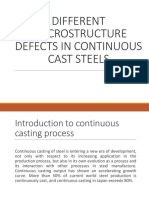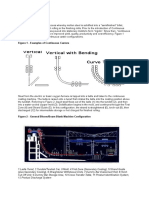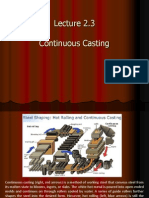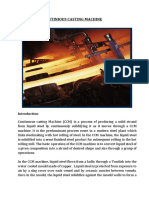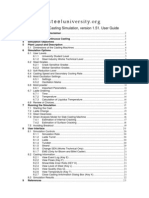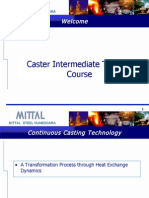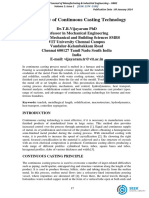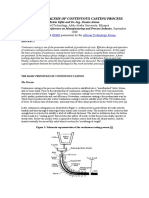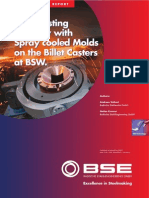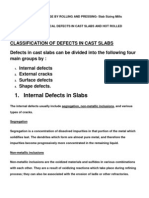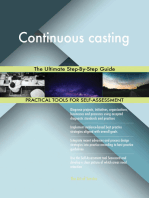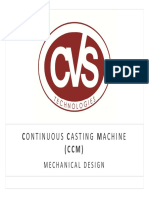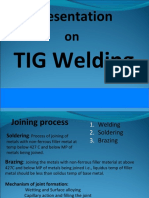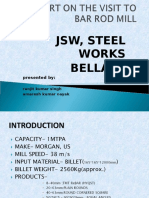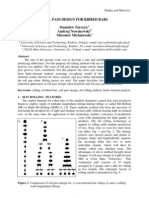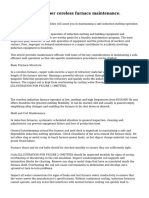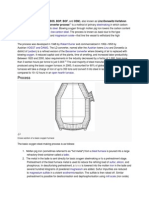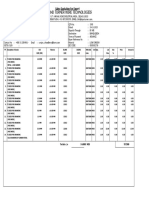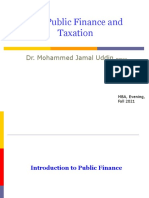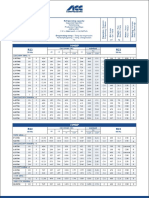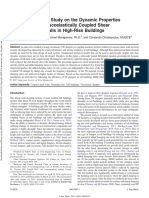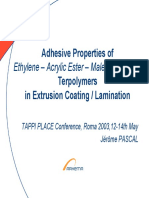CCM Breakout
CCM Breakout
Uploaded by
Metoo ChyCopyright:
Available Formats
CCM Breakout
CCM Breakout
Uploaded by
Metoo ChyOriginal Title
Copyright
Available Formats
Share this document
Did you find this document useful?
Is this content inappropriate?
Copyright:
Available Formats
CCM Breakout
CCM Breakout
Uploaded by
Metoo ChyCopyright:
Available Formats
See discussions, stats, and author profiles for this publication at: https://www.researchgate.
net/publication/329916020
Breakout Problems Study of Continuous Casting Steel
Article · August 2012
CITATIONS READS
0 740
1 author:
Sahib Mahdi
Mustansiriyah University
15 PUBLICATIONS 5 CITATIONS
SEE PROFILE
Some of the authors of this publication are also working on these related projects:
Fatigue Behavior of Heat Treated AZ31 Magnesium Alloy View project
Influence of Heat Treatment on the Drawability and Strain Hardening Index for Low Carbon Al - Killed Steel Sheets View project
All content following this page was uploaded by Sahib Mahdi on 26 December 2018.
The user has requested enhancement of the downloaded file.
Journal of Materials and Metallurgical Engineering
Volume 2, Issue 2, August 2012, Pages 1-11
___________________________________________________________________________
Breakout Problems Study of Continuous Casting Steel
Saheb Mohammed Mahdi*
Materials Engineering Department, Al-mustansiriya University-Baghdad-Iraq
ABSTRACT
The breakout is one of greatest problems in the continuous casting processes. We can return most
of their reasons on the bad control of casting process circumstances, including the chemical
composition of the metal, pouring speed and temperature, as well as operation processes control.
In this research, the breakout heats had been constrained for the period of ten months, for (ST 52)
type steel .From the operating data, remarked that most breakout heats was out of the upper limit
pouring temperature. Breakout is also appearing to be effect by the chemical composition.
Although Manganese percent of the steel was within limits, but it is effect to induce breakout in
indirect manner. Increase Silicon content will increase the fluidity of molten steel, leading to
increase the ferro-static pressure on solidified shell causing breakout. The increase in Carbon
percent has a positive effect in decreasing breakouts. From actual operating effect on breakout, it
is found that most breakouts were of first sequence of the heat, which it means that casting
preparation was unsuitable. Breakout can be eliminate or avoid by compliance with operation
instructions.
Keywords: Continuous casting, Breakout, Heat sequence, mould (mold), strand
* Author for correspondence E-mail: sahebmahdi@yahoo.com; Tel. No. 00964-7707279486
1. INTRODUCTION containing a core of liquid steel [5,7]. After
enough metal has solidified, the dummy bar is
Continuous casting process is one of then slowly withdrawn down from the bottom
significant production techniques, because of of the mould at a controlled casting speed, on
its efficient way to solidify large volumes of exit from the mould the strand enters the
metal into simple shapes [1,2]. Figure 1 shows secondary cooling zone, which gradually
an illustration of continuous casting process. solidifies as the strand moves down until
Relative to other casting processes, continuous completely freeze [8]. Breakout is the earlier
casting generally has a higher capital cost, but continuous casting technical problem [2,6],
lower operating cost [3,4]. It’s an energy where the solidifying steel shell sticks to the
efficient production method, with high quality mould, tears initiation allows molten steel to
[5]. The process is started by plugging the pour over the bottom of the machine. It is
bottom of the mould with a "dummy bar"; difficult to specify accurately the breakout
molten steel is transported from the melting reasons [9,10]. Many attempts and
furnace to the continuous casting machine investigation had been applied to overcome
with a ladle. The ladle feeds the tundish, and breakouts. Safe caster operation (without
then tapping into the mould [6]. The molten metal breakout) and achievement of acceptable
steel freezes against the water-cooled walls of product quality require understanding of both
the copper mould to form a solid shell engineering and metallurgy of solidification.
ISSN: 2231–3818© STM Journals 2012. All Rights Reserved Page 1
Journal of Materials and Metallurgical Engineering
Volume 2, Issue 2, August 2012, Pages 1-11
___________________________________________________________________________
Liduidus temperature (Tliq) must be known for Tliq = 1536 –{78(%C) + 7.6(%Si) +
all types of casting. It is important for 4.9(%Mn)} ……………………..(3)
controlling solidification of a metal. Always This is true with error (±4oC). From the
casting temperature be enough higher than Formula (3), the temperatures of pouring, ladle
metal liquidus temperature (Tliq) to facilitate before and after treatment and the tundish can
pouring (increase castability). For continuous be calculating [11].
casting practically found that: The main incidentals of the breakout
(Pouring Temp. Tp) Tp = Tliq + 25oC phenomenon are, lowering production
……… (1) efficiency, increasing the expense price of
o
(Ladle Temp. TL) TL = Tliq + 65 C liquid steel tonnage, time lost on maintenance
……….. (2) and worker exposed to hazards [12–18].
Moreover, for calculating liquidus
temperature, by knowing steel main alloying
content, the formula is
Fig. 1: Show Illustration of Continuous Casting Process [6].
2. WORKING PROCEDURE 1. Pursuing the weekly reports of the casting
heats for ten months (the period of this
As mentioned, it is difficult to give an accurate study). Then sorting the heats that been
reason for Breakout. In this research, the aim sustained of breakout.
is to study effects of chemical composition of 2. Arrange the operating values of the
steel on breakout occurrence. The following breakout heats in suitable tables.
steps were applying for obtaining this 3. The tabulated data are schematically
research: drawn, showing upper and lower limits
ISSN: 2231–3818© STM Journals 2012. All Rights Reserved Page 2
Journal of Materials and Metallurgical Engineering
Volume 2, Issue 2, August 2012, Pages 1-11
___________________________________________________________________________
value. To facilitate, fixing the out limits 2. Effect of Manganese percent: From the
heats .As shown in Figures (2–5). operating values for the chemical
4. Analysis and discuss these values, in order composition of (ST52) steel grade.
to specify the breakout reasons. Comparing the Mn% in steel with correct
operating instruction and from Figure 3 , it
3. RESULTS is found that 32 breakout heats of Mn%
content in the steel lays within lower limit.
Table I shows the chemical composition of the 3. Effect of Silicon percent: Figure 4 shows
steel grade ST52 (in DIN specification). This the heats that had been breakout because
grade of steel was study during the ten months of the Silicon percent in the molten steel.
period. From the weekly operating reports and Most heats are within limits except 13 of
compared with the standard operating values, 42. Where 12 heats were out of upper limit
42 heats have been suffer from breakout. and one is out of lower limit.
Although this problem is relatively few. 4. Effects of Carbon percent: Figure 5 shows
Nevertheless, its effects are effective on the the heats that had been breakout with the
production rate where it needs from few days upper and lower limits of Carbon percent
to many hours for repairing the production line in steel. It is clear that most heats are
as well as other mentioned effects. For detects within the limit range, except six heats are
the reason of these breakout heats, according out of the lower limit.
to pouring temperature, the main alloying 5. Effect of chemical composition on pouring
content elements and the operation procedure temperature: Figure 6 show the effect of
it was: pouring temperature that has been
calculated from the Formulas (3) and (1).
1. Pouring Temperature effect: Through It is clear that all point are in the upper
observing the operating values for the limits. But this figure tells us the real
tundish temperature of the steel grade temperatures that must be taken in the
(ST52). Table I show the chemical process, whereas the actual pouring
composition of this steel. Figure 2 show temperature are shown in Figure 1.
the relation between the breakout heats 6. Continuous casting machine state:
that occurs during the study period with Figure 7 shows the number of breakouts
temperature limit that be allowed. It is that have been take place in each month of
seen that 19 heats of 42 are above the studying period. This figure is represent
o
upper limit that been allowed (1534 C), the actually truth operating for period of
where is only 4 heats are within lower the study.
limit (1514 oC), the rest are within upper 7. Bad preparation of continuous casting
limit. machine: From pursuing the breakout
ISSN: 2231–3818© STM Journals 2012. All Rights Reserved Page 3
Journal of Materials and Metallurgical Engineering
Volume 2, Issue 2, August 2012, Pages 1-11
___________________________________________________________________________
heats and its relation with heat sequence of number of heats of the first sequence in
casting steps, it is remarked rising in casting steps as shown in Figure 8.
Table I: The Chemical Composition of the Steel ST52 due to DIN Specifications.
C% Si % Mn % P% S%
ST52
Min. Max. Min. Max. Min. Max. Min. Max. Min. Max.
0.34 0.38 0.2 0.25 1.00 1.30 0000 0.04 0000 0.04
Fig. 2: The Pouring Temperature of the Molten Steel for the Heats that Suffer Breakout in the
Period of the Study.
ISSN: 2231–3818© STM Journals 2012. All Rights Reserved Page 4
Journal of Materials and Metallurgical Engineering
Volume 2, Issue 2, August 2012, Pages 1-11
___________________________________________________________________________
Fig. 3: The Manganese Percent in the Molten Steel for the Heats that Suffer Breakout in the Period of
the Study.
0.45
0.4
0.35
0.3
Silicon %
0.25
Max. Limit
0.2
Min. Limit
0.15
0.1
Nov.
May Jun July Aug. Sep. Oct. Dec. Jan. February
Month of study
Fig. 4: The Silicon Percent in the Molten Steel for the Heats that Suffer Breakout in the Period
of the Study.
ISSN: 2231–3818© STM Journals 2012. All Rights Reserved Page 5
Journal of Materials and Metallurgical Engineering
Volume 2, Issue 2, August 2012, Pages 1-11
___________________________________________________________________________
Fig. 5: The Carbon Percent in the Molten Steel for the Heats that Suffer Breakout in the Period
of the Study.
Fig. 6: The Calculated Pouring Temperature of the Molten Steel for the Heats that Suffer Breakout in
the Period of the Study as a Function of the Chemical Compositio006E.
ISSN: 2231–3818© STM Journals 2012. All Rights Reserved Page 6
Journal of Materials and Metallurgical Engineering
Volume 2, Issue 2, August 2012, Pages 1-11
___________________________________________________________________________
Fig. 7: Number of Breakouts that Happens in each Month in the Period of the Study.
Fig. 8: Number of Breakouts for each Heat Sequence of Casting that Happens in the Period of the
Study.
ISSN: 2231–3818© STM Journals 2012. All Rights Reserved Page 7
Journal of Materials and Metallurgical Engineering
Volume 2, Issue 2, August 2012, Pages 1-11
___________________________________________________________________________
5. DISCUSSION molten steel , and the rise of slag
proportion as well as increase in sulfur
To discuss the results percent in the molten steel, which delay
1) For pouring Temperature effect: From freezing that cause to breakout. The reason
Figure 2 the rise of pouring temperature is the formation of iron sulfide that
will increase the super heat (it is the precipitated on grain-boundary. Moreover
difference between the liquidus temp. and because of low melting temperature of
the casting temp.) ,which must be not iron sulfide (985 oC), this regions are
exceed (±10) oC. This increasing in remain in liquid state for long time. The
temperature will execute to form thin importance of ferro-Manganese addition is
shell, and extend the liquid metal length in for Oxygen removal from the steel. The
the core of the strand, which will increase formation of Manganese oxide will mixed
the ferro-static pressure of the molten with slag, to insure cast strand be empty of
steel. This pressure can be creating crakes bubbles gas, as well as the formation of
in the frozen shell and then breakout agitation. Manganese can be reacting with
occurs. Silicon to form Manganese silicate, which
However, the reasons that increase the has low density that can be float with the
temperature could be: slag, to ease taking out from the surface.
a) The bad order between the time of pouring Lowering Manganese to Silicon ratio in
from the furnace with the heats sequence. the molten steel leads to Silica
b) The temperature of ladle's molten steel is precipitates, which are of high melting
Inhomogeneous. temperature and high density, that will
c) Tundish temperature is at superheat, sink in the molten steel .Silica presence
because of high pouring temperature. within the freezing shell will form a weak
d) Temperature measurement gages must be zones cannot withstand the ferro-static
calibrating from time to time. pressure of the molten steel leads to
In addition, we must note that the decrease in breakout.
pouring temperature below the minimum 3) For the Silicon percent effect: From
allowed temperature. Could be cause breakout, Figure 4 the additive of ferro-Silicon is
the metal sticking with the internal mold walls. more than required or it is not completely
This case of breakout dose not happened in consumed during iron reduction .The main
our study. purpose of ferro-Silicon additive is to
2) For the Manganese percent effect: From reduce iron oxide and form the slag ,where
Figure 3 the additive quantity of ferro- the soluble Silicon will increase the
Manganese is less than required ,which fluidity of molten steel. The Silicon Oxide
was the reason of inhomogeneous of that forms from reduction will float on the
ISSN: 2231–3818© STM Journals 2012. All Rights Reserved Page 8
Journal of Materials and Metallurgical Engineering
Volume 2, Issue 2, August 2012, Pages 1-11
___________________________________________________________________________
liquid surface with the slag. Silicon breakout in month (10). The reason was
content increasing made molten steel easy incompetence of X-ray instrument that
to flow, any default in the freezing shell used to control molten steel level inside
can help to breakout occurrence. the mold. The other reason was
4) For the Carbon percent effect: From insufficient maintenance before start
Figure 5 the increase in Carbon percent casting, where most breakouts happened in
has a positive effect in decreasing the first sequence of the heats.
breakouts. The increasing Carbon percent 7) For bad preparation of continuous casting
in molten steel leads to decrease metal machine: From Figure 8 the breakouts
solidifying temperature and vice versa is occurrence are because of the following
true .Low Carbon percent content of liquid factors :
steel will retain it in a liquid stat for longer a) Insufficient maintenance was before
time. This will elongate the molten core of start casting.
the strand .Here it is very important to take b) Misapplying the operating instructions of
attention of direct and indirect mold and continuous casting machine supplying in
exit strand cooling. Alternatively, this right way, like :-
positive case will turn to cause breakout. i) Wrong measurement of mold walls
5) From Figure 6, that represents the inclination.
calculated pouring temp. According to the j) Empty space exists between the narrow
main steel alloying elements (C% ,Mn% wall and wide wall of the mold.
and Si%). It is clear that all heats are k) Improper dummy bar preparation, and bad
within the upper casting tem. Limit. That mold powder was use.
is true if these temperatures were the
casting temperatures. Really Figure 2 CONCLUSIONS:
show the actual pouring temperatures,
where they are much higher than From the actual practice and the schematically
calculated temperatures. Indicating that in figures, conclusions are:
all cases, it was a super heat, and the 1. As pouring temperature to upraise more
chemical composition effect in raising the than allowed limits, the breakouts
temperature above that must be. Breakout increased, because of the freezing shell
happens if the pouring temperature is too cannot withstand the ferro-static pressure
high, because the solidify shill will be of the molten steel.
thin, that cannot standing against the 2. As the Manganese and Carbon percent
Ferro-static pressure. decreased and Silicon increase, the
6) For Continuous casting machine state: probability of breakout will increase. As
From Figure 7 There is a steep rise of well as pouring temperature increase with
ISSN: 2231–3818© STM Journals 2012. All Rights Reserved Page 9
Journal of Materials and Metallurgical Engineering
Volume 2, Issue 2, August 2012, Pages 1-11
___________________________________________________________________________
steel alloying elements increases causing 7. S. Mazumdar and S. K. Ray
to breakout. "Solidification Control in Continuous
3. Bad continuous casting machine Casting of Steel". Sadhana. Vol. 26. Parts
preparation is one of breakout reasons. 1 & 2, February–April 2001. 179–198p.
4. Breakout happens because of, bad India.
misapplying the operating instructions and 8. M. Velicka, R. Pyszko, M. Prihoda, et al.
bad supplement the casting operation. METALURGIJA.2009. 48(4). 277–280p.
9. Kenneth C. Mills. "Mold Powders For
REFERENCES: Continuous Casting". Chapter 8. The
AISE Steels Foundation. Pittsburgh. PA.
1. F. R. Camisani, Calzorari I.K. Craig, P. C. Copy right 2003.
Pistorius "Control Structure for the 10. Albert J. Moore, R. J. Phillips, T. R. Gibbs
reduction of defects in Continuous "An Overview For The Requirements Of
th
Casting".15 Triennial World Congress. Continuous Casting Mould Fluxes".
Barcelona. Spain. 2002. Foseco Internation Limited. Steelmaking
2. Haruyoshi Tanabe and Masay Uki Conference Proceedings. 1991.
Nakada. "Steel Making Technologies www.foseco-steel.com.
Contributing to steel industries ". NKK 11. Hans F. Schrewe “Continuous Casting Of
Technical Review. No.88. 2003. 18–27 p . Steel: Fundamental Principles And
3. I. S. Kim, J. S. Son, H. J. Kim, B. S. Sung. Practice”, Düsseldorf. Stahleisen. Copy
Journal of Achievements in Materials and right 1989.
Manufacturing Engineering. 2008. 2. 12. Greene et al. "Continuous Caster Breakout
683–689p. Damage Avoidance System" United State
4. Takahiko Ichiki , Katsumi Miyamoto, Patent. Patent Number: 4,809,766. Date of
Kazumi Katou. " Cooling – water Patent: Mar. 7,1989.
circulation core for casting Hollow ingts " 13. II Sohn and Asish Sinha Materials Science
. Furukawa Review. No.20. 2001. 95–100 Forum. 2010. 654–656. 394–397p.
p. 14. Blazevic. D , Ikonic. M , Mikac. T "
5. Migual A. Barro , Jesus Gonzalez , Felipe Metalurgija. 2008. 47(1). 47–50p.
Vargas-Villamil. "Control of molten steel 15. Zhao Lian-Gang, Zhang. Hui. Journal of
level in a continuous caster using an Iron and Steel Research. 2007. 19(5).
alternative procedure ". AISE. 2001. 29–33p.
Pittsburgh. PA . 16. X. S. Zheng, M. H. She, J. Z. Jin. Acta
6. B. G. Thomas "Continuous Casting". Metallurgica sinice(English Letters).
Elsevier Science Ltd. Oxford. U.K. Vol.2. 2005. 19(3). 176–182.
2001. 1595–1599p.
ISSN: 2231–3818© STM Journals 2012. All Rights Reserved Page 10
Journal of Materials and Metallurgical Engineering
Volume 2, Issue 2, August 2012, Pages 1-11
___________________________________________________________________________
17. M. R. Ridolfi, A. De Vito, L. Ferro.
Metallurgical And Materials Transactions
B. 2008. 39(4) 581–592p.
18. P. Hemy, R. Smylie, and C. Srinivasan.
JOM. 2002. 54(1).
19. Saheb M. Mahdi, Dohrgam Alkafajee ,
Najem A. Saeed. The Iraqi Journal for
Mech. And Materials Eng. 2005. 5. In
Arabic.
ISSN: 2231–3818© STM Journals 2012. All Rights Reserved Page 11
View publication stats
You might also like
- Billet DefectsDocument56 pagesBillet Defectsziad92% (12)
- Loop Laying HeadDocument21 pagesLoop Laying HeadHarsha Reddy100% (4)
- Macrostructure Defect in Continuous Steel CastingDocument13 pagesMacrostructure Defect in Continuous Steel CastingHasna RiazNo ratings yet
- CCMDocument10 pagesCCMHeet PatelNo ratings yet
- Billet DefectsDocument29 pagesBillet Defectsnqvinh_dnNo ratings yet
- Presentation On RhomboidityDocument9 pagesPresentation On Rhomboidityrehan787100% (3)
- Fig 1 Some of The Ladle Metallurgy ProcessesDocument4 pagesFig 1 Some of The Ladle Metallurgy ProcessesNikesh KoliNo ratings yet
- A Brief About TundishDocument16 pagesA Brief About TundishOm Prakash Tenduwe100% (3)
- PSV and PRV PDFDocument5 pagesPSV and PRV PDFMetoo Chy100% (2)
- AHU FAHU - AnnuallyDocument3 pagesAHU FAHU - AnnuallyDreamliner100% (1)
- Mould Fluxes in The Steel Continuous Casting ProcessDocument30 pagesMould Fluxes in The Steel Continuous Casting ProcessUgur KayaNo ratings yet
- Continuous Casting of Steel PDFDocument10 pagesContinuous Casting of Steel PDFStefan MihalacheNo ratings yet
- EAT227-Lecture 2.3 - Continuous CastingDocument25 pagesEAT227-Lecture 2.3 - Continuous CastingSurya Da Rasta100% (1)
- CCM Equipment Detail For ClearanceDocument5 pagesCCM Equipment Detail For ClearancesmithNo ratings yet
- Steel: Continuous Casting Simulation, Version 1.51. User GuideDocument23 pagesSteel: Continuous Casting Simulation, Version 1.51. User GuideBiswadeb Ghosh100% (1)
- Copper MouldsDocument6 pagesCopper Mouldsherbie_astaNo ratings yet
- Continuous CastingDocument4 pagesContinuous Castingklawsis100% (1)
- CC Training CourseDocument53 pagesCC Training CourseVasile VazdauteanuNo ratings yet
- Induction Furnace Working Principle - Mechanical EngineeringDocument5 pagesInduction Furnace Working Principle - Mechanical Engineeringjalilemadi0% (1)
- Presentation BASICS Continuous CastingDocument25 pagesPresentation BASICS Continuous CastingDeepakGawas100% (1)
- Metallurgy of Continuous Casting TechnologyDocument20 pagesMetallurgy of Continuous Casting Technologyahmed ebraheemNo ratings yet
- A Review of RhomboidityDocument10 pagesA Review of RhomboidityShrey GulatiNo ratings yet
- The Study of Continuous Rolling Mill Inter-Stand T PDFDocument8 pagesThe Study of Continuous Rolling Mill Inter-Stand T PDFSantosh Kumar Pandey100% (1)
- Thermal Analysis of Continuous Casting Process (Maryeling)Document10 pagesThermal Analysis of Continuous Casting Process (Maryeling)Marko's Brazon'No ratings yet
- CastingDocument48 pagesCastingGauravBhatt100% (1)
- 1 - Rolling of Metals Flat Rolling and Shape RollingDocument29 pages1 - Rolling of Metals Flat Rolling and Shape RollingThulasi RamNo ratings yet
- Iron Carbon DiagramDocument9 pagesIron Carbon DiagramNagamuthu PandianNo ratings yet
- Casting Defect in Slab PDFDocument55 pagesCasting Defect in Slab PDFBhoomaiah SunkenapalliNo ratings yet
- Lecture Casting InSteelCon 2007Document8 pagesLecture Casting InSteelCon 2007radynasrNo ratings yet
- Continuous Casting User ManualDocument22 pagesContinuous Casting User ManualMyo100% (1)
- Billet Defects - Pinhole and Blowhole Formation, Prevention and Evolution PDFDocument10 pagesBillet Defects - Pinhole and Blowhole Formation, Prevention and Evolution PDFSebastian KrdnasNo ratings yet
- Rolling DefectsDocument8 pagesRolling Defectsvelavansu100% (2)
- Mold Oscillation and Negative Strip Time PDFDocument14 pagesMold Oscillation and Negative Strip Time PDFPrakash Sarangi100% (1)
- Induction FurnaceDocument7 pagesInduction FurnaceDeepak Velusamy100% (2)
- Reducing Electrode ConsumptionDocument143 pagesReducing Electrode ConsumptionAbhishekamAlankaram100% (1)
- Steel MakingDocument35 pagesSteel MakingBharichalo007No ratings yet
- Quality Problems in Continuous Cast ProductsDocument47 pagesQuality Problems in Continuous Cast Productsmanas burmaNo ratings yet
- Chapter 5 - Welding Joint Design and Welding SymbolsDocument43 pagesChapter 5 - Welding Joint Design and Welding Symbolsyves suarezNo ratings yet
- Iron Carbon Equillibrium Diagram GandhidhamDocument22 pagesIron Carbon Equillibrium Diagram Gandhidhamcal2_uniNo ratings yet
- Ladle RefractoryDocument26 pagesLadle RefractoryRavindra Kashyap100% (2)
- Induction Furnace PresentationDocument14 pagesInduction Furnace PresentationRajdeep SikdarNo ratings yet
- Are View of The Rhomboid It y Problem in Billet CastingDocument11 pagesAre View of The Rhomboid It y Problem in Billet CastingSuhaib AshrafNo ratings yet
- CCM Mechanical-Design PresentationDocument63 pagesCCM Mechanical-Design PresentationRavi Kant kumarNo ratings yet
- Billet Casting DefectsDocument18 pagesBillet Casting DefectsMuhammad Hassan100% (1)
- Annex 1 CCM ProcessDocument16 pagesAnnex 1 CCM ProcessehsanNo ratings yet
- CH 4-Gating System and RiseringDocument63 pagesCH 4-Gating System and RiseringGosaye Desalegn100% (1)
- Multi SlittingDocument6 pagesMulti Slittingeng_ahmedkassemNo ratings yet
- TIG Presentation.Document31 pagesTIG Presentation.Md Anamul HoqueNo ratings yet
- Steel - Continuous CastingDocument11 pagesSteel - Continuous CastingAli AzharNo ratings yet
- Secondary Steel Making DraftDocument25 pagesSecondary Steel Making DraftSanjeev Sahu100% (2)
- Billet Continuous CasterDocument17 pagesBillet Continuous CasterziadNo ratings yet
- JSW, Steel Works Bellary: Presented byDocument26 pagesJSW, Steel Works Bellary: Presented byRakesh Karan Singh100% (1)
- Types of Furnaces Used in CastingDocument29 pagesTypes of Furnaces Used in CastingMurali100% (1)
- CONTINUOUS CASTING ColloquiumDocument18 pagesCONTINUOUS CASTING ColloquiumakritiNo ratings yet
- Roll Pass Design For Ribbed BarsDocument8 pagesRoll Pass Design For Ribbed BarsDiaa KassemNo ratings yet
- 19338-Technical Specification - R1 (001-250)Document250 pages19338-Technical Specification - R1 (001-250)Jesus SevillaNo ratings yet
- Guidelines For Proper Coreless Furnace Maintenance.Document7 pagesGuidelines For Proper Coreless Furnace Maintenance.iowafurnace83100% (2)
- Basic Oxygen SteelmakingDocument11 pagesBasic Oxygen SteelmakingRahul Pandey100% (1)
- Continuous CastingDocument67 pagesContinuous CastingPatel Ki Bahu100% (1)
- Breakout Problems Study of Continuous CaDocument11 pagesBreakout Problems Study of Continuous CaazizsultanNo ratings yet
- Met 55 2 249 252Document4 pagesMet 55 2 249 252Zvone DadićNo ratings yet
- Chapter - 7 - Standard Costs and VariancesDocument17 pagesChapter - 7 - Standard Costs and VariancesMetoo ChyNo ratings yet
- Chapter 8Document57 pagesChapter 8Metoo ChyNo ratings yet
- Economic Planning of BD.Document23 pagesEconomic Planning of BD.Metoo ChyNo ratings yet
- Chapter - 9 - Differential Analysis The Key To Decision MakingDocument23 pagesChapter - 9 - Differential Analysis The Key To Decision MakingMetoo ChyNo ratings yet
- Lesson 03 - Public Expenditure PolicyDocument18 pagesLesson 03 - Public Expenditure PolicyMetoo ChyNo ratings yet
- Chapter 3 Ob & Essential of BusinessDocument10 pagesChapter 3 Ob & Essential of BusinessMetoo ChyNo ratings yet
- Gov of BD and BD. Economy.Document20 pagesGov of BD and BD. Economy.Metoo ChyNo ratings yet
- Lesson 04 - A - Budget SystemDocument38 pagesLesson 04 - A - Budget SystemMetoo ChyNo ratings yet
- Chapter 5 (Dealing With Competition)Document46 pagesChapter 5 (Dealing With Competition)Metoo ChyNo ratings yet
- Lecture 1 - IntroductionDocument11 pagesLecture 1 - IntroductionMetoo ChyNo ratings yet
- Chapter 2 Business SystemDocument6 pagesChapter 2 Business SystemMetoo ChyNo ratings yet
- Lesson 02 - Market Failure, Public Goods & ExternalitiesDocument19 pagesLesson 02 - Market Failure, Public Goods & ExternalitiesMetoo ChyNo ratings yet
- Chapter 1 Concept and Branches of BusinessDocument11 pagesChapter 1 Concept and Branches of BusinessMetoo ChyNo ratings yet
- Lesson 05 - Fiscal Policy and StabilizationDocument48 pagesLesson 05 - Fiscal Policy and StabilizationMetoo ChyNo ratings yet
- Ajex and Turner Wire Technologies: Party DetailsDocument2 pagesAjex and Turner Wire Technologies: Party DetailsMetoo ChyNo ratings yet
- Lesson 01 - IntroductionDocument35 pagesLesson 01 - IntroductionMetoo ChyNo ratings yet
- KPI: Individual Performance To Make Organization GreatDocument28 pagesKPI: Individual Performance To Make Organization GreatMetoo Chy100% (1)
- Face2face Emd2end Dimensions of Valves ASME B16 10Document9 pagesFace2face Emd2end Dimensions of Valves ASME B16 10Metoo ChyNo ratings yet
- COA - Graphite FinesDocument1 pageCOA - Graphite FinesMetoo ChyNo ratings yet
- TSV and PSV PDFDocument5 pagesTSV and PSV PDFMetoo ChyNo ratings yet
- Zinc-Coated (Galvanized) Steel Core Wire For Aluminum Conductors, Steel Reinforced (ACSR)Document4 pagesZinc-Coated (Galvanized) Steel Core Wire For Aluminum Conductors, Steel Reinforced (ACSR)Metoo Chy100% (1)
- Reverse Air Forced Type APC System Design CriterionDocument2 pagesReverse Air Forced Type APC System Design CriterionMetoo ChyNo ratings yet
- Corrosion - Example Problems PDFDocument11 pagesCorrosion - Example Problems PDFMetoo ChyNo ratings yet
- Rod Given To Wastern Marine. Date Dia Quantity 17.06.13 2.6 5 KG 17.06.14 3.2 5 KGDocument1 pageRod Given To Wastern Marine. Date Dia Quantity 17.06.13 2.6 5 KG 17.06.14 3.2 5 KGMetoo ChyNo ratings yet
- Corrosion - Example Problems PDFDocument11 pagesCorrosion - Example Problems PDFMetoo ChyNo ratings yet
- Microsoft PowerPoint - Lesson 8 ValvesDocument19 pagesMicrosoft PowerPoint - Lesson 8 ValvesJosue BrazNo ratings yet
- Gate ValveDocument222 pagesGate ValveMetoo ChyNo ratings yet
- Chapter 20. Thermodynamics: The First Law of ThermodynamicsDocument18 pagesChapter 20. Thermodynamics: The First Law of ThermodynamicsMiguel MartínezNo ratings yet
- New IMportant StandardsDocument1 pageNew IMportant StandardsfacadeNo ratings yet
- Ceiling Work OutlineDocument37 pagesCeiling Work OutlineOmar ZakiNo ratings yet
- Solid State Crystaline StructureDocument20 pagesSolid State Crystaline StructurehumejiasNo ratings yet
- BE Sem VII CivilEngg Adv Earthquake EngineeringDocument4 pagesBE Sem VII CivilEngg Adv Earthquake Engineeringanimehub040103No ratings yet
- JFK-174.115.B009 - 033010 - Concrete Spec.Document50 pagesJFK-174.115.B009 - 033010 - Concrete Spec.Glenn NewmarkNo ratings yet
- Composites Whitepaper 5 Laminate Theory 0Document17 pagesComposites Whitepaper 5 Laminate Theory 0JeroenNo ratings yet
- Annexure For Items CoveredDocument130 pagesAnnexure For Items CoveredPrashanth KvnNo ratings yet
- X.Electrolux R12 R22Document5 pagesX.Electrolux R12 R22Jesus Grillet50% (2)
- Repsol Hydroflux Ep PDFDocument1 pageRepsol Hydroflux Ep PDFrandiNo ratings yet
- Wire RodDocument71 pagesWire RodTeka KamNo ratings yet
- Figure B7.37. Modified Kansas Corral Bridge Rail (6,7,51,52)Document15 pagesFigure B7.37. Modified Kansas Corral Bridge Rail (6,7,51,52)shams-87No ratings yet
- 3-Layer Polypropylene Coating: High Temperature Corrosion ProtectionDocument2 pages3-Layer Polypropylene Coating: High Temperature Corrosion Protectiona.hasan670100% (1)
- Flexible, Number Coded, 0,6/1kV, Meter MarkingDocument1 pageFlexible, Number Coded, 0,6/1kV, Meter Markingbaguspermana7No ratings yet
- RAILCORP - Telecommunications - Outdoor - Cabling - StandardDocument18 pagesRAILCORP - Telecommunications - Outdoor - Cabling - StandardScooby DooNo ratings yet
- Problem 6: Answer: 138.24kN, 157.93kN, 304kNDocument1 pageProblem 6: Answer: 138.24kN, 157.93kN, 304kNMarvin Carl GranadaNo ratings yet
- Flow Tek Ball Valve Selection Guide PDFDocument6 pagesFlow Tek Ball Valve Selection Guide PDFeghbali2255No ratings yet
- Analytical Study On The Dynamic Properties of Viscoelastically Coupled Shear Walls in High-Rise BuildingsDocument11 pagesAnalytical Study On The Dynamic Properties of Viscoelastically Coupled Shear Walls in High-Rise BuildingsKrishnakumar ThanirosanNo ratings yet
- Blast Furnace Stove Refractory Findings and Innovative SolutionsDocument12 pagesBlast Furnace Stove Refractory Findings and Innovative SolutionsBalaji B HNo ratings yet
- Manufacturing Process of GlassDocument6 pagesManufacturing Process of GlassAida SuhanumNo ratings yet
- Nitowrap FRC: Constructive SolutionsDocument2 pagesNitowrap FRC: Constructive SolutionsbinodNo ratings yet
- Acrylic EsterDocument27 pagesAcrylic EsterrabiulfNo ratings yet
- ME 2012 Solved PDFDocument22 pagesME 2012 Solved PDFTavi SharmaNo ratings yet
- H.R.Steel Industries: Job Card For M 20X2.5X 155 MM Hex Bolt (HSFG)Document1 pageH.R.Steel Industries: Job Card For M 20X2.5X 155 MM Hex Bolt (HSFG)mahesh agarwalNo ratings yet
- Roof Floor: Vacp (4 LOOP)Document1 pageRoof Floor: Vacp (4 LOOP)Muhammad KaleelNo ratings yet
- Daikin LV Series Sim Duct-FDXS-Operation-ManualDocument30 pagesDaikin LV Series Sim Duct-FDXS-Operation-ManualsearchwriterNo ratings yet
- 3D Crystal PlaneDocument1 page3D Crystal PlaneCallueet CullenNo ratings yet
- ForgingDocument23 pagesForgingRajeev RanaNo ratings yet
- Basic of TransformerDocument13 pagesBasic of Transformerunnati.sharma100% (1)


